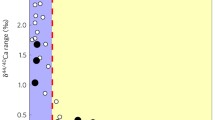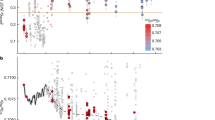Abstract
Relatively soon (∼0.2 Ga) after the Earthformed, it is likely that major oceans appeared in ahot (∼100°C) reducing environment where carbondioxide was probably the dominant atmospheric gas,with PCO2, values reaching perhaps in excess of 10atm. During the Hadean Eon between 4.3 and 3.8 Ga BP,major changes in the concentration of atmosphericCO2 and associated temperature changes had aprofound influence on the carbonate geochemistry ofthe Hadean Ocean. Although no rocks are known to havesurvived prior to the Archean Eon, it is stillpossible to calculate approximate values for importantseawater parameters during the Hadean Eon based onother sources of information and reasonableassumptions about processes such as weatheringreactions.
Our calculations are based on a linear temperaturechange from 100°C to 70°C and logPCO2 change from 1 to -1.5 over the Hadean Eon. Over this range in temperature and P CO2, theinfluence of T is relatively small, but changes inP CO2 result in large compositional variations inthe carbonate chemistry of Hadean seawater. In theearly Hadean, seawater pH was probably about5.8 ± ∼ 0.2, DIC may have reached close to 130 mM,and alkalinity was perhaps close to 30 mM. By thelate Hadean, seawater pH probably had changed to closeto neutral (∼6.8), and DIC and alkalinity were closerto present-day values. Even large uncertainties inNa+ + Cl-, K+ and Mg2+concentrations produce relatively small uncertaintiesin our calculated values for the carbonic acid system. However, larger uncertainties result from reasonableranges for Ca2+ concentrations and the saturationstate of Hadean seawater with respect to calcite.
Our calculations support the hypothesis that acarbonate chemistry of seawater roughly similar tothat of modern oceans could have been acquired veryearly in Earth history. If seawater composition werebuffered by reactions involving carbonates andsilicates, then the composition of late Hadean-earlyArchean seawater was not vastly different from that oftoday. Thus, by the conclusion of the Hadean Eon, ifnot before, environmental conditions at the Earth's surface, including temperature and seawatercomposition, were sufficiently equable for theevolution of life, including the Archaebacteria: theextreme halophiles and thermophiles and methanogens.Contrary to the hypothesis of an early Na-bicarbonateocean, our calculations suggest the possibility thatthe early oceans of Earth were a NaCl-dominatedaqueous solution, with somewhat higher DIC andalkalinity concentrations, higher saturation state,and the possibility of lower calcium concentrations.The time course of approach of Hadean seawater to acarbonate composition closer to that of today isdifficult to predict. It is distinctly possible thatthe concentration of calcium in seawater did not reachlevels like that of modern seawater until the latePrecambrian and thus constrained the timing of the"Big Bang" of organic evolution, the emergence of theshelled invertebrates at the beginning of thePhanerozoic.
Similar content being viewed by others
References
Berner, R. A., Lasaga, A. C., and Garrels, R. M. (1983) The carbonate-silicate geochemical cycle and its effect on atmospheric carbon dioxide over the past 100 million years. Amer. J. Sci. 283, 641–683.
Brock, T. D. (1973) Lower pH limit for the existence of blue-green algae: evolutionary and ecological implications. Science 179, 480–483.
Broecker, W. S. (1971) A kinetic model for seawater composition. Quaternary Res. 1, 188–207.
Chave, K. E. (1960) Evidence on history of seawater. Bull. Am. Assoc. Petroleum Geologists 44, 357–370.
Chyba, C. F. (1987) The cometary contribution to the oceans of primitive Earth. Nature 330, 632–635.
Cloud, P. (1968) Atmospheric and hydrospheric evolution on the primitive Earth. Science 160, 729–736.
Cloud, P. (1972) A working model of the primitive Earth. Amer. J. Sci. 272, 537–548.
Cloud, P. (1973) Paleocological significance of the banded iron formations. Econ. Geology 68, 1135–1143.
Dimroth, E. and Kimberley, M. M. (1976) Precambrian atmospheric oxygen: evidence in the sedimentary distributions of carbon, sulfur, uranium, and iron. Canadian Journal of Earth Science 13, 1161–1185.
Des Marais, D. J., Strauss, H., Summons, R. E., and Hayes, J. M. (1992) Carbon isotopic evidence for the stepwise oxidation of the Protorozoic environment. Nature 359, 605–609.
Frank, L. A. and Sigwarth, J. B. (1993) Atmospheric holes and small comets. Reviews of Geophysics 31, 1–28.
Garrels, R. M. and Christ, C. L. (1965) Solutions, Minerals, and Equilibria. New York, New York: Harper and Row.
Garrels, R.M. and Mackenzie, F. T. (1971) Evolution of Sedimentary Rocks. New York: W. W. Norton and Company.
Garrels, R. M. and Mackenzie, F. T. (1972) A quantitative model for the sedimentary rock cycle. Marine Chemistry 1, 27–41.
Garrels, R. M., Perry, Jr., and Mackenzie, F. T. (1973) Genesis of Precambrian iron-formations and the development of atmospheric oxygen. Economic Geology 68, 1173–1179.
Grotzinger, J. P. and Rothman, D. H. (1996) An abiotic model for stromatolite morphogenesis. Nature 383, 423–425.
Grotzinger, J. P. (1993) New views of old carbonate sediments. Geotimes 38, 12–15.
Hardie, L. A. (1996) Secular variation in seawater chemistry: An explanation for the coupled secular variation in the mineralogies of marine limestones and potash evaporites over the past 600 m. y. Geology 24, 279–283.
Hayes, J. M. (1994) Global methanotrophy at the Archean-Proterozoic transition. In Early Life on Earth (ed. S. Bengtson), pp. 220–236. Nobel Symposium No. 84, New York, Columbia University Press.
He, S. and Morse, J. W. (1993) The carbonic acid system and calcite solubility in aqueous Na-K- Ca-Mg-Cl-SO4 solutions from 0 to 90°C. Geochim. Cosmochim. Acta 57, 3533–3555.
Holland, H. D. (1972) The geologic history of sea water-an attempt to solve the problem. Bull. Geological Society of America 36, 637–651. Holland, H. D. (1984) The Chemical Evolution of the Atmosphere and Oceans. Princeton, New Jersey: Princeton University Press.
Holland, H. D. (1992) Distribution and paleoenvironmental interpretation of Proterozoic paleosols. In The Proterozoic Biosphere: a multidisciplinary study (eds. J.W. Schopf and Klein, C.), pp. 153–155. Cambridge University Press.
Holland, H. D. (1994) In Early Life on Earth (ed. S. Bengston), pp. 237–244. Nobel Symposium No. 4, Columbia University Press, N.Y.
Holser, W. T., Schidlowski, M., Mackenzie, F. T., and Maynard, J. B. (1988) Geochemical cycles of carbon and sulfur. In Chemical Cycles in the Evolution of the Earth (eds. C. B. Gregor, Garrels, R. M., Mackenzie, F. T., and Maynard, J. B.), pp. 105–173. John Wiley & Sons, N.Y.
Karhu, J. A. and Holland, H. D. (1996) Carbon iosotopes and the rise of atmospheric oxygen. Geology 24, 867–870.
Kasting, J. F. (1987) Theoretical constraints on oxygen and carbon dioxide concentrations in the Precambrian atmosphere. Precambrian Res. 34, 205–229.
Kasting, J. F. (1992) Models relating to Proterozoic atmospheric and oceanic chemistry. In The Proterozoic Biosphere (eds. W. J. Schopf and Klein, C.), pp. 1185–1187. Cambridge University Press, Cambridge, UK.
Kasting, J. F. (1997) Warming Earth and Mars. Science 276, 1213–1215.
Kasting, J. F. and Ackerman, T. P. (1986) Climatic consequences of very high CO2 levels in the Earth's early atmopshere. Science 234, 1383–1385.
Kempe, S. and Degens, E. T. (1985) An early soda ocean? Chem. Geol. 53, 95–108.
Kempe, S., Kazmierczak, J., and Degens, E. T. (1989) The soda ocean concept and its bearing on biotic evolution. In Origin, Evolution, and Modern Aspects of Biomineralization in Plants and Animals (ed. R. E. Crick), pp. 29–39. Plenum Press, N.Y.
Lafon, M. G. and Mackenzie, F. T. (1974) Early Evolution of the Oceans - A Weathering Model. In Studies in Paleo-Oceanography (ed. William Hay), pp. 205–218. Society of Economic Paleontologists and Mineralogists, Special Publication No. 20.
Levinton, J. S. (1992) The big bang of animal evolution. Scientific American, November, 84–91.
Mackenzie, F. T. (1975) Sedimentary cycling and the evolution of sea water. In Chemical Oceanography, 2nd ed., v. 1 (eds. J. P. Riley and Skirrow, G.), pp. 309–364. Academic Press, London.
Mackenzie, F. T. and Morse, J. W. (1992) Sedimentary carbonates through Phanerozoic time. Geochim Cosmochim. Acta 56, 3281–3296.
Morse, J. W. and He, S. (1993) Influences of T, S and PCO2 on the pseudo-homogeneous nucleation of calcium carbonate from seawater: Implications for whiting formation. Mar. Chem. 41, 291–298.
Morse, J. W. and Mackenzie, F. T. (1990) Geochemistry of Sedimentary Carbonates, Elsevier, Amsterdam 707.
Morse, J. W., Wang, Q. and Tsio, M. Y. (1997) Influences of temperature and Mg:Ca ratio on the mineralogy of CaCO3 precipitated from seawater. Geology 25, 85–87.
Mojzsis, S. J., Arrhenius, G., McKeegan, K. D., Harrison, T. M., Nutman, A. P., and Friend, C. R. L. (1997) Evidence for life on Earth before 3,800 million year ago. Nature 384, 55–59.
Ohmoto, H. (1992) In Early Organic Evolution: Implications for Mineral and Energy Resources (eds. M. Schidlowski, Golubic, S., Kimberley, M. M., Mckirdy, D. M. and Trudinger, P. A.), pp. 378–397. Springer-Verlag, Berlin.
Ohmoto, H. (1996) Evidence in pre-2.2 Ga paleosols for the early evolution of atmospheric oxygen and terrestrial biota. Geology 24, 1135–1138.
Ohmoto, H. (1997) When did the Earth's atmosphere become oxic? Newsletter of The Geochemical Society, No. 93, pp. 12–13, 26-27.
Ohmoto, H., Kakegawa, T., and Lowe, D. R. (1993) 3.4-billion-year-old biogenic pyrites from Barberton, South Africa: Sulfur isotopic evidence. Science 262, 555–557.
Owen, T., Cess, R. D., and Ramanathan, V. (1979) Early Earth: An enhanced carbon dioxide greenhouse to compensate for reduced solar luminosity. Nature 277, 640–642.
Rubey, W.W. (1951) Geologic history of sea water: an attempt to state the problem. Bull. Geological Society America 62, 1111–1148.
Rye, R., Kuo, P. H., and Holland, H. D. (1995) Atmospheric carbon dioxide concentrations before 2.2 billion years ago. Nature 378, 603–605.
Sagan, C. and Chyba, C. (1997) The early faint sun paradox: Organic shielding of ultraviolet-l abile greenhouse gases. Science 276, 1217–1221.
Sillen, L. G. (1961) The physical chemistry of seawater. In Oceanography (ed. M. Sears), pp. 549–581. AAAS Publication No. 67, Washington, D.C.
Spencer, R. J. and Hardie, L. A. (1990) Control of seawater composition by mixing of river waters and mid-ocean ridge hydrothermal brines. In Fluid-Mineral Interactions: A Tribute to H. P. Eugster, The Geochemical Society, Spec. Pub. No. 2, 409–419.
Sumner, D. Y. (1997) Carbonate precipitation and oxygen stratification in late Archean seawater as deduced from facies and stratigraphy of the Gamohaan and Frisco Formations, Transvaal Supergroup, South Africa. Amer. J. Sci. 297, 455–487.
Sylvester, P. J., Campbell, I. H. and Bowyer, D. A. (1997) Niobium/uranium evidence for early formation of the continental crust. Science 275, 521–523.
Sylvester, P. J. (1998) Formation of the continents - dribble or big bang. The Geochemical News #94 12–25.
Veizer, J. (1988) The evolving exogenic cycle. In Chemical Cycles in the Evolution of the Earth (eds. C. B. Gregor, Garrela, R. M., Mackenzie, F. T., and Maynard, J. B.), pp. 175–220. John Wiley & Sons, N.Y.
Walker, J. C. G. (1977) Evolution of the Atmosphere. Macmillan, N.Y.
Walker, J. C. G. (1983) Possible limits on the composition of the Archean ocean. Nature 302, 518–520.
Walker J. C. G. (1985) Carbon dioxide on the early earth. Origins of Life 16, 117–127.
Walker, J. C. G., Hays, P. B. and Kasting, J. F. (1981) A negative feedback mechanism for the long-term stabilization of Earth's surface temperature. J. Geophys. Res. 86, 9776–9782.
Walker, J. C. G. and Brimblecombe, P. (1985) Iron and sulfur in the pre-biologic ocean. Precambrian Research 28, 205–222.
Watanabe, Y., Naraoka, H., Wronkiewicz, D. J., Condie, K. C., and Ohmoto, H. (1997) Carbon, nitrogen, and sulfur geochemistry of Archean and Proterozoic shales from the Kaapvall Craton, South Africa. Geochim. et Cosmochim. Acta 61, 3441–3459.
Rights and permissions
About this article
Cite this article
Morse, J.W., Mackenzie, F.T. Hadean Ocean Carbonate Geochemistry. Aquatic Geochemistry 4, 301–319 (1998). https://doi.org/10.1023/A:1009632230875
Issue Date:
DOI: https://doi.org/10.1023/A:1009632230875




